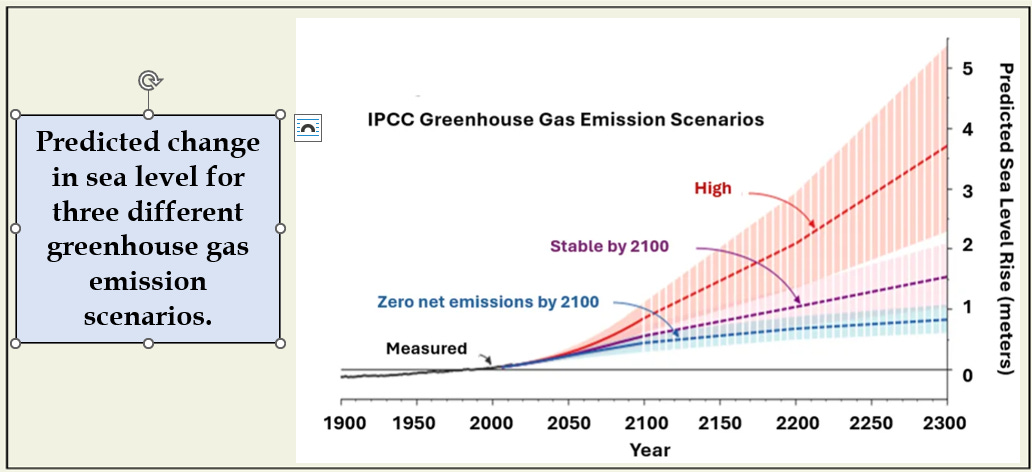Why We CAN Predict Our Climate Future
Weather is just noise along the path we have charted for global climate change
This essay is a short one as it is built on a few iconic images that have been presented several times in previous posts. Long-term measurements of carbon dioxide, temperature and a few other global indicators make it clear where we are headed.
The reason for telling this tale again here is to pair it with two previous essays on the difficulty in predicting weather, and suggest that what we experience as weather is just internal noise in terms of the global net energy balance that drives long-term climate change. We can’t predict the noise very well, but we can predict that long-term balance.
Weather is Just Noise in the Global Climate System
Two previous essays have presented reasons why we can’t predict the weather in any one place more than a few days in advance, and how regional oscillations in the climate system can deflect long-term changes in global climate change for months to years.
But all of this daily to yearly variation is just so much noise within the global climate system. Energy received at the surface of Earth varies widely by latitude and season. The dynamic currents in the atmosphere and oceans, and the weather they cause, result from this energy inequality. On the other hand, global average temperature is the expression of a global energy balance (solar energy input minus radiation back out to space) and is only modestly affected by temporal variation in this redistribution within the system.
By increasing the concentration of greenhouse gases in the atmosphere, we have shifted the long-term global energy balance towards higher average temperatures. How that increased energy plays out in terms of short-term variation in any particular location (weather) is just noise relative to our long-term climate trajectory.
The climate stability that has characterized the entire span of human history and culture occupies a very narrow range of possible climates, as reconstructions over previous geological eras shows. The Earth has been hotter and colder at different times, far beyond ranges that could sustain the 10 billion people predicted to share the planet by 2060. We could be driving the climate system out of that comfort zone once again.
What we consider major disruptions to modern life due to weather extremes, even the most extreme events that continue to increase in frequency, are just minor blips in the global energy system.
We know where we are going, the pathway might just be a little noisy.
Long-term Trends in Carbon Dioxide and Temperature Are Clear and Consistent
This story can be told in a short series of graphs that capture the most important trends.
Central to the story are the carefully measured changes in carbon dioxide in the atmosphere and global temperatures, and the relationship between the two. Together they tell an unavoidable tale. In terms of the span of human history, we are in uncharted territory for both of these indicators.
Everything we know about greenhouse gases, from the discovery of their infrared radiation absorption capacity (in the 1850s) to how they should affect global climate, is reinforced by the clear relationship between carbon dioxide and temperature seen in the next image below. Variation around this trend line is largely explained by the state of the ENSO oscillation. The range of variation in climate model predictions that has led to the discussion of the inability of the modeling community to explain what happened in 2023 is contained within the bracket in the upper right of this diagram. Small potatoes relative to the total change over the last 65+ years. Again, just noise in the long-term trend.
We can also repeat here the distillation of 30 years of IPCC effort into the diagram below showing how past increases in temperature and future predictions can all be related to cumulative carbon dioxide emissions. To repeat another message from previous essays, carbon dioxide is not the only greenhouse gas, but the most important one AND a powerful index, so far, to all the changes in the radiation balance of the Earth that we are causing.
Loss of Ice, Rising Seas and Increasing Storms
Loss of sea ice in the Arctic Ocean is one of the most visible impacts of global warming, and although melting of ice already afloat in the oceans does not raise sea levels, similar increases in loss from glaciers and ice caps does. Disruptions to date from rising seas are due to an increase of less than one-third of a meter. There are no scenarios that predict lower sea levels.
Increases in the total seasonal energy embedded in and released by tropical storms in the North Atlantic, which has nearly doubled since 1900, is just one weather outcome of a more energetic climate system. More frequent heat waves, droughts, intense rainfall events and other weather extremes are other examples.
We Know Where We Are Headed
So, unlike next week’s or next year’s weather in your location, our collective future in terms of the energy balance of the Earth driving changes in temperature, oceans and ice is abundantly clear.
Weather is just noise along the path.
We can choose to change that path. Will we?
Sources
Data on carbon dioxide concentrations as measured on Mauna Loa are here:
https://scrippsco2.ucsd.edu/graphics_gallery/mauna_loa_record/
The temperature record is from the Goddard Institute for Space Studies and is here:
https://data.giss.nasa.gov/gistemp/
The image from the IPCC on cumulative carbon dioxide emissions and temperature is here:
https://www.ipcc.ch/report/ar6/wg1/figures/summary-for-policymakers/figure-spm-10
The image of projected sea level rise is here:
https://www.climate.gov/news-features/understanding-climate/climate-change-global-sea-level
Data on the energy in tropical storms in the North Atlantic over time is from this site:









